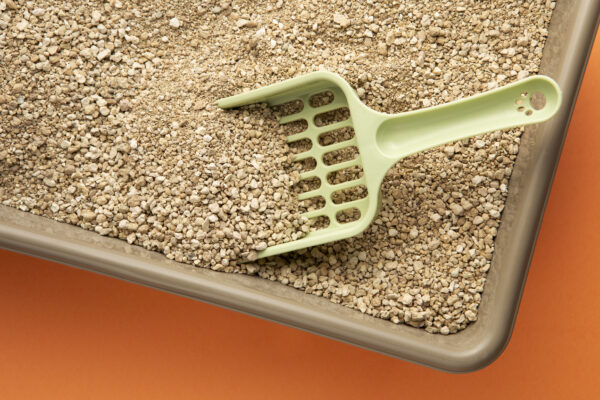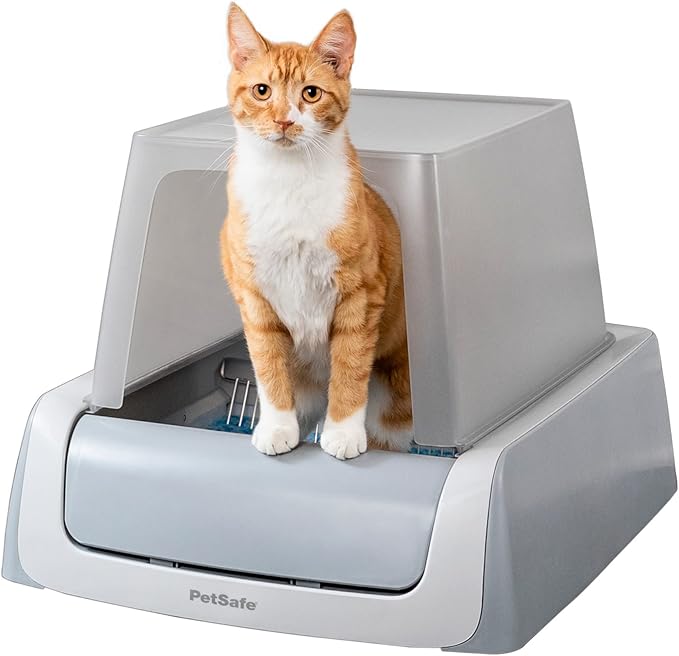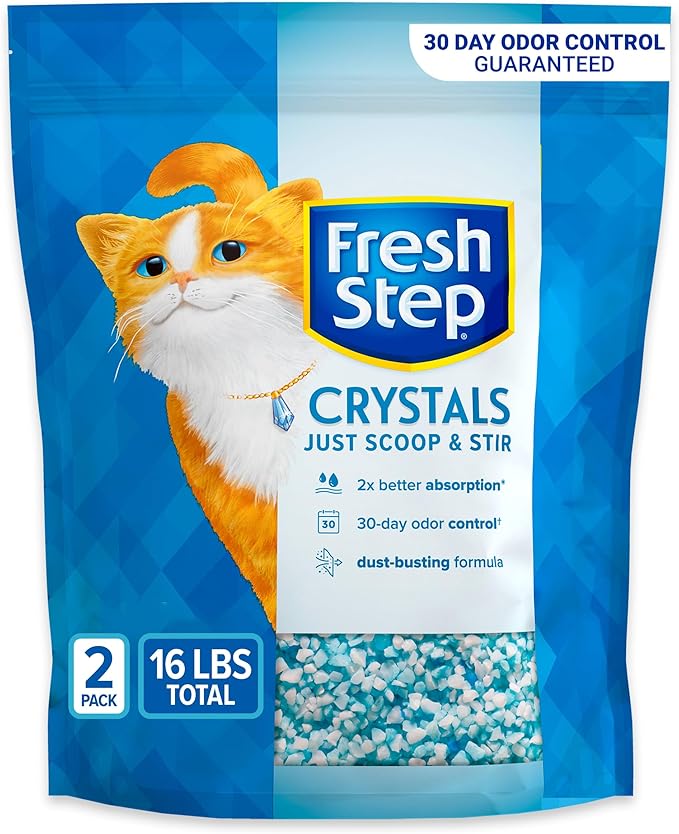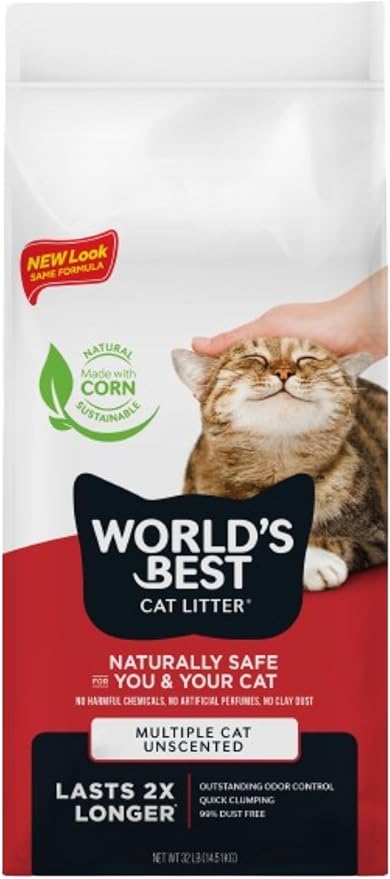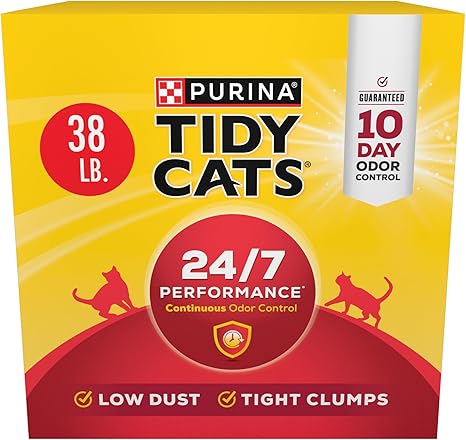Struggling with smelly litter boxes, tracking issues, or a finicky cat who refuses their litter? You’re not alone. Finding the best cat litter can feel overwhelming with hundreds of options promising the world but delivering disappointment.
Whether you’re dealing with persistent odors, litter scattered throughout your home, or a cat who’s suddenly avoiding their box, this comprehensive guide will help you solve these problems once and for all.
As cat behavior experts and litter testing specialists, we’ve analyzed every major litter type available in 2025 to bring you science-backed recommendations. This guide covers everything from clumping clay vs crystal litter to troubleshooting common litter box problems, helping you create a cleaner, fresher home for both you and your feline friend.
Table of Contents
Clumping Clay Cat Litter: Most Popular Choice
Made from bentonite clay, clumping cat litter forms hard, scoopable clumps when wet, making daily maintenance simple and effective.
There’s a reason clumping clay has dominated the cat litter market for over three decades. When your cat uses the box, the bentonite clay particles immediately bind with moisture, creating tight, solid clumps that you can scoop out with a single motion. This means you’re only removing the soiled portions, leaving the rest of the litter fresh and ready for the next use. The result? A cleaner box that lasts longer and saves you money over time.
What makes clumping clay particularly appealing to both cats and their humans is its familiar texture. The fine granules closely mimic the sandy soil that cats instinctively prefer for elimination, which is why even the pickiest felines typically accept it without hesitation. Plus, with prices starting as low as 50 cents per pound, it’s the most budget-friendly option that doesn’t compromise on performance.
Benefits:
- Excellent odor control (traps ammonia in solid clumps)
- Easy daily scooping and cleaning
- Most affordable option ($0.50-$1.50 per pound)
- Widely available at all major retailers
Things to Consider:
- Can be dusty (problematic for cats with asthma)
- Heavy to carry (20-40 lb bags)
- Tracks easily due to fine granules
- Not eco-friendly (strip-mined bentonite clay)
Best for: Budget-conscious owners who prioritize easy maintenance and strong odor control
Crystal Cat Litter (Silica Gel): Low-Maintenance Option
Crystal cat litter uses silica gel beads that absorb up to 40 times their weight in liquid while dehydrating solid waste to control odors naturally.
If you’ve ever wished you could spend less time maintaining your cat’s litter box, crystal litter might be your answer. These tiny silica gel beads work like microscopic sponges, absorbing urine completely while allowing moisture to evaporate, leaving behind dry, odorless crystals. Unlike traditional clay that forms muddy clumps, crystal litter maintains a clean, dry texture throughout its use cycle. This means you can go weeks between complete litter changes while simply scooping solid waste daily.
The magic happens at the molecular level: each crystal contains millions of tiny pores that trap liquid and odor-causing bacteria. When you stir the crystals daily (a 30-second task), you’re redistributing the moisture and ensuring maximum absorption capacity. Many cat owners are amazed to discover that a single bag of crystal litter can outlast three bags of traditional clay, making the higher upfront cost surprisingly economical over time.
Benefits:
- Superior odor control (can last 2-4 weeks per change)
- Virtually no tracking
- Lightweight and easy to handle
- Low dust formulation
- Longer-lasting than clay options
Things to Consider:
- Higher upfront cost ($2-4 per pound)
- Some cats dislike the texture
- Requires daily stirring to distribute moisture
- Cannot scoop urine like clumping litter
Best for: Owners seeking minimal tracking and extended odor control with less frequent changes
Natural Cat Litter: Eco-Friendly & Safe Options
Natural cat litter options are made from renewable, biodegradable materials that are safer for cats with allergies and better for the environment.
The natural litter revolution isn’t just about being environmentally conscious—it’s about creating a healthier environment for both you and your cat. These plant-based alternatives eliminate the dust clouds that can trigger respiratory issues, while their renewable sources mean you’re not contributing to destructive strip mining operations. What’s particularly impressive is how these natural materials often outperform traditional clay in specific areas: corn naturally neutralizes ammonia odors, walnut shells create incredibly tight clumps, and wood pellets expand to absorb far more liquid than you’d expect.
For cat owners dealing with allergies, post-surgical recovery, or simply wanting to reduce their environmental pawprint, natural litters offer compelling advantages. Many cats with sensitivities to traditional clay dust show immediate improvement when switched to paper or corn-based options. Plus, if your curious kitten decides to sample their litter (as many do), natural ingredients are far safer than processed clay with added chemicals.
Corn-Based Cat Litter
Benefits:
- Lightweight and flushable (check local regulations)
- Excellent clumping and odor control
- Safe if accidentally ingested
- Dust-free formulation
Things to Consider:
- Higher cost ($1.50-$2.50 per pound)
- May attract insects if not stored properly
- Some cats may have corn allergies
Wood Pellet Cat Litter
Benefits:
- Natural pine scent helps control odors
- Low tracking due to larger pellet size
- Most affordable natural option ($0.75-$1.25 per pound)
- Biodegradable and sustainable
Things to Consider:
- Breaks down into sawdust when wet
- Requires sifting system for best results
- May not clump as firmly as clay
- Pine scent may be too strong for sensitive cats
Paper Cat Litter
Benefits:
- Dust-free and hypoallergenic
- Ideal for post-surgery recovery
- Highly absorbent
- Soft texture gentle on sensitive paws
Things to Consider:
- Doesn’t clump effectively
- Average odor control compared to other types
- Requires more frequent complete changes
- Can become soggy if overly saturated
Walnut Shell Cat Litter
Benefits:
- Superior odor absorption
- Hard clumping action
- Natural and biodegradable
- Good value for natural option
Things to Consider:
- Dark color may hide urine color changes
- Mid-range pricing ($1.25-$2.00 per pound)
- May cause allergic reactions in sensitive cats
- Less widely available than other types
Best for: Eco-conscious owners, cats with respiratory sensitivities, and households prioritizing natural products
The Best Natural Cat Litters (2025): A Deep Dive into Corn, Wood, and Walnut
How to Choose the Best Cat Litter: Problem-Solution Guide
Quick Reference: Match Your Problem to the Right Litter
| Your Main Problem | Recommended Litter Type | Top Brand Picks |
|---|---|---|
| Strong ammonia odors | Clumping clay or crystal litter | Dr. Elsey’s Ultra, Fresh Step Crystals |
| Litter tracking everywhere | Crystal or large pellet litters | PrettyLitter, Feline Pine, corn pellets |
| Picky/fussy cat | Unscented fine-grain clay | Dr. Elsey’s Cat Attract, Arm & Hammer Unscented |
| Multiple cats (3+ cats) | Multi-cat clumping clay | Tidy Cats 24/7, Arm & Hammer Super Scoop |
| Dust and respiratory issues | Crystal, corn, or paper litter | Fresh Step Crystals, World’s Best, Fresh News |
| Environmental concerns | Plant-based biodegradable | World’s Best (corn), Naturally Fresh (walnut) |
| Budget constraints | Standard clumping clay | Tidy Cats Non-Stop Odor Control |
| Easy cleanup/maintenance | Crystal litter | PrettyLitter, Ultra Pet Crystals |
Essential Cat Litter Box Setup: Complete Guide
The best cat litter is only effective with proper litter box setup. Here’s what every cat owner needs to know:
Choosing the Right Litter Box
Size Requirements:
- Minimum: 1.5 times your cat’s body length
- Width: At least as wide as your cat is long
- Depth: 2-3 inches of litter (never more than 4 inches)
Box Types:
- Open boxes: Preferred by most cats, better ventilation
- Covered boxes: Good for privacy but may trap odors
- Self-cleaning boxes: Convenient but expensive ($200-$600)
The foundation of successful litter box management starts with choosing the right container, and size truly matters more than most people realize. A box that’s too small forces your cat into uncomfortable positions, potentially leading to accidents or complete avoidance of the box. The golden rule of 1.5 times your cat’s body length isn’t arbitrary—it allows for natural digging, turning, and positioning behaviors that cats need to feel secure while eliminating. Many behavioral problems stem from cramped quarters that make cats feel vulnerable or unable to properly cover their waste.
When it comes to covered versus uncovered boxes, think like a cat: would you prefer using a bathroom with or without an escape route? While covered boxes appeal to humans for odor containment and privacy, many cats find them claustrophobic and trap-like. The confined space can also concentrate ammonia odors, making the environment unpleasant for your sensitive-nosed feline. If you do choose a covered box, ensure it’s large enough that your cat doesn’t feel trapped and consider removing the door flap, which many cats dislike having to push through.
Must-Have Litter Box Accessories
High-Quality Litter Mats (reduces tracking by 80-90%)
- Look for textured surfaces or honeycomb designs
- Place directly outside litter box exit
- Available at Chewy, Amazon, Petco for $15-$40
Proper Scooping Tools
- Metal scoops last longer than plastic
- Choose slotted design matching your litter type
- Replace every 6-12 months
Odor Control Products
- Baking soda-based deodorizers (Arm & Hammer)
- Avoid strong fragrances that may deter cats
- Consider air purifiers for litter box areas
The right accessories can transform your litter box experience from a daily chore into a quick, manageable task. A high-quality litter mat is arguably the most important investment you’ll make—the difference between a $5 basic mat and a $25 honeycomb design is dramatic. The textured surfaces actively pull litter granules from your cat’s paws as they exit, while the raised edges contain scattered litter rather than letting it spread throughout your home. Position the mat so your cat must step on it when leaving the box, and choose one large enough that they can’t easily step around it.
Quality scooping tools make daily maintenance infinitely easier and more hygienic. While plastic scoops seem economical, they often crack or retain odors, and their flexibility makes it harder to break through stubborn clumps. A well-designed metal scoop with appropriately sized slots (matching your litter type) will last years and make the scooping process faster and more thorough. For odor control products, less is often more—strong artificial fragrances can actually deter cats from using their box, while simple baking soda-based deodorizers neutralize odors without overwhelming sensitive feline noses.
Final Thoughts: Your Path to the Perfect Cat Litter Solution
Bottom Line: Finding the best cat litter requires matching your specific needs—whether that’s odor control, tracking reduction, or accommodating a finicky feline—with the right litter type and proper maintenance routine. Start with our recommendations above, transition gradually, and don’t be afraid to experiment until you find your perfect match.
After testing dozens of litter brands and helping thousands of cat owners solve their litter box challenges, we’ve learned that there’s no universal “best” cat litter—only the best litter for your specific situation. The good news? Armed with the knowledge in this guide, you’re now equipped to make an informed decision that will transform your daily routine and create a happier environment for both you and your cat.
Remember that successful litter management is a system, not just a product. The highest-rated litter in the world won’t solve your problems if it’s paired with an undersized box, placed in a high-traffic area, or maintained inconsistently. Take a holistic approach: choose the right litter type for your primary challenge, invest in quality accessories like proper mats and scoops, and commit to a regular maintenance schedule. Most importantly, be patient during transitions and pay attention to your cat’s preferences—they’re usually trying to tell you something important.
Whether you’re dealing with persistent odors, excessive tracking, or a cat who’s suddenly boycotting their box, the solutions exist. Start with our problem-solution matching table to identify your best litter type, follow our transition guidelines to avoid rejection, and don’t hesitate to consult your veterinarian if behavioral changes persist. Your ideal litter setup is out there waiting to be discovered—and with these expert insights, you’re well on your way to finding it.
Ready to upgrade your litter game? Check out our detailed reviews of the top-rated cat litters available in 2025, and don’t forget to bookmark this guide for future reference as your cat’s needs evolve.
Frequently Asked Questions About Cat Litter
Q: What’s the best cat litter for odor control? A: Crystal (silica gel) litters like PrettyLitter and Fresh Step Crystals offer superior odor control, lasting 2-4 weeks. For budget options, try Dr. Elsey’s Ultra clumping clay.
Q: How often should I change cat litter completely?
A: Clumping litter: every 2-4 weeks. Crystal litter: every 3-4 weeks. Non-clumping: weekly. Multiple cats require more frequent changes.
Q: Is expensive cat litter worth it? A: Premium litters often provide better odor control and last longer, making cost-per-use comparable. Crystal litters may cost more upfront but require less frequent changing.
Q: Can I flush cat litter down the toilet? A: Only litters specifically labeled “flushable” and only if local sewer systems allow it. Most clumping clay litters will clog pipes. Check municipal guidelines first.
Q: What’s the best cat litter for multiple cats? A: High-performance clumping clay designed for multi-cat households (Tidy Cats 24/7, Arm & Hammer Multi-Cat) or crystal litters that handle heavy usage.
References
- Carney, H.C., Sadek, T.P., Curtis, T., et al. (2014). AAFP and ISFM guidelines for diagnosing and solving house-soiling behavior in cats. Journal of Feline Medicine and Surgery, 16(7), 579-598.
- Consumer Reports. (2025). Best Cat Litter From Our Tests. Retrieved from https://www.consumerreports.org/home-garden/best-cat-litter-a1408378942/
- Cornell University College of Veterinary Medicine. (2024). Feline Behavior Problems: House Soiling. Cornell Feline Health Center. Retrieved from https://www.vet.cornell.edu/departments-centers-and-institutes/cornell-feline-health-center/health-information/feline-health-topics/feline-behavior-problems-house-soiling
- Purina. (2017). How to Switch Cat Litter and Avoid Problems. Purina US. Retrieved from https://www.purina.com/articles/cat/behavior/litter/how-to-switch-cat-litter
- American Association of Feline Practitioners (AAFP) & International Society of Feline Medicine (ISFM). (2013). Feline Environmental Needs Guidelines. Journal of Feline Medicine and Surgery, 15(3), 219-230.
Last updated: July 2025

